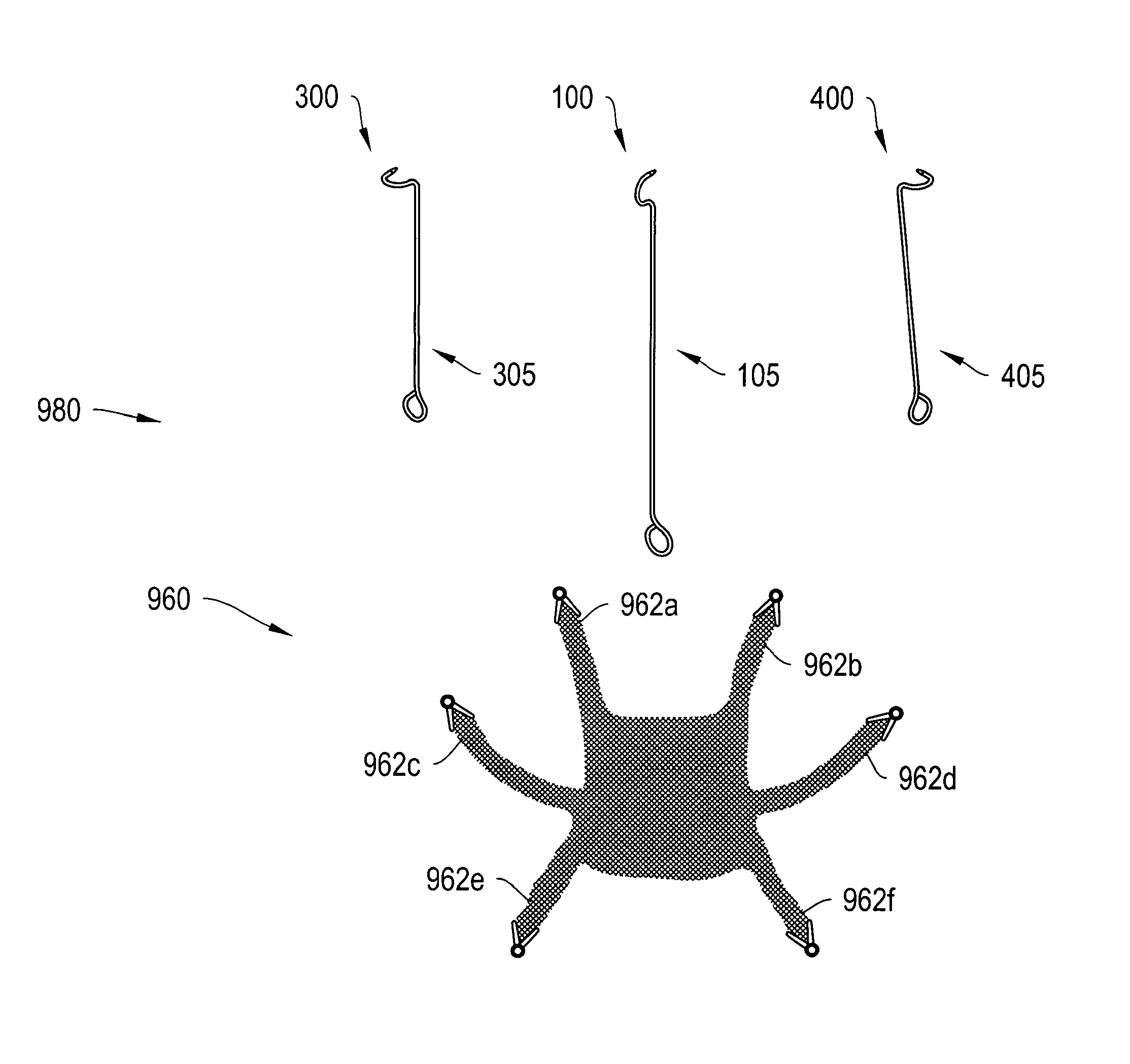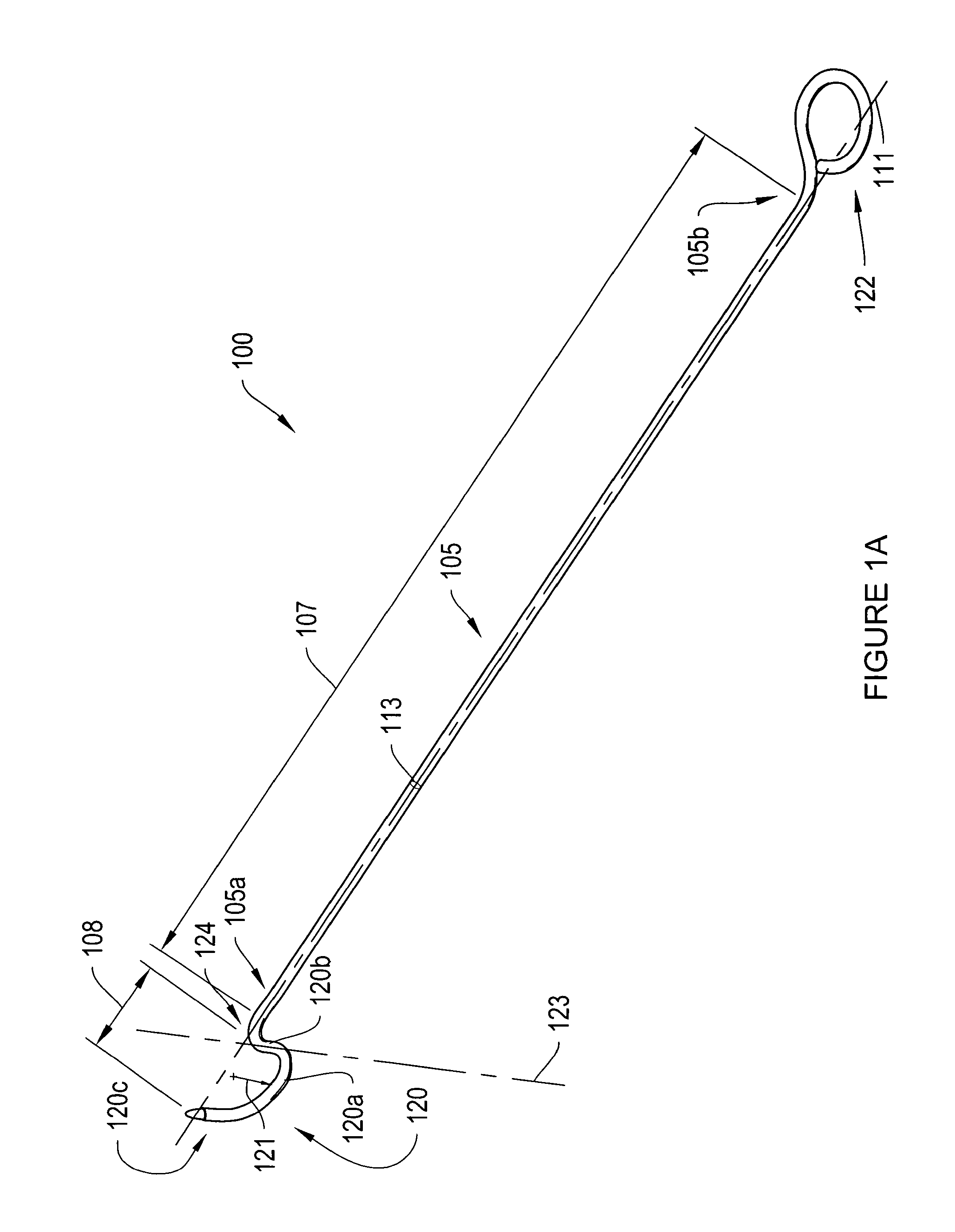Systems, devices and methods for treating pelvic floor disorders
a technology of pelvic floor and system, applied in the field of systems, devices and methods for treating pelvic floor disorders, can solve the problems of increasing intra-abdominal pressure, exacerbate female urinary incontinence, urine leakage out of the urethra during stressful activity, etc., and achieve the effect of stabilizing the pelvic region and promoting tissue growth
- Summary
- Abstract
- Description
- Claims
- Application Information
AI Technical Summary
Benefits of technology
Problems solved by technology
Method used
Image
Examples
embodiment 101
[0042]The shaft 105 is shown to be substantially linear, but it may be slightly curved to form either a convex or a concave arc to further facilitate delivery of the head. FIG. 1B illustrates an alternate embodiment 101 of the delivery device 100 of FIG. 1A having a curved shaft 103 instead of the linear shaft 105 of FIG. 1A. The curved shaft 103 may facilitate passage of the device through the vaginal canal to access the sacrospinous ligament or coccygeus muscle of the patient. In addition, the curved shaft allows rotation of the delivery device 101 for insertion of the head 120 into the patient's tissues. This may be done, for example, by applying a force in direction 140 to the proximal end 103b of the device 101 thereby rotating the device about the middle area 103c of the shaft 103 such that the distal end 103a of the shaft 103 and the head 120 rotate into the tissues in the direction 141. The amount of curvature will typically be chosen to facilitate delivery of the device int...
embodiment 300
[0050]FIG. 3 shows an alternative embodiment 300 of the device of FIG. 1A having a head 320 oriented perpendicularly to the shaft 305 to allow the operator to deliver a surgical implant to a region of a patient's levator ani muscle, such as the tendinous arch of the levator ani or the iliococcygeus muscle, through a vaginal incision. The levator ani muscle is a broad, thin muscle situated generally on the side of the pelvis that is attached to the inner surface of the lesser pelvis. It is a convenient location to anchor mesh straps in order to provide lateral and / or posterior support and tension for a surgical implant. The iliococcygeus is a portion of the levator ani muscle originating from the ischial spine and the arcus tendineus levator ani and sloping inferiorly toward the midline. The iliococcygeus includes fibers that blend with the longitudinal muscle of the rectum.
[0051]As shown, the delivery device 300 is similar to the device 100, but its head 320 is positioned about 90 d...
embodiment 400
[0052]FIG. 4 shows an alternative embodiment 400 of the device 100 of FIG. 1a having a head 420 oriented on the contra lateral side of its shaft 405 compared to the head 320 and shaft 305 of FIG. 3. The device 400 is then suited to deliver a surgical implant, such as a pelvic floor mesh strap, to a region of a patient's levator ani muscle contra-lateral to the region of the levator ani muscle discussed with respect to FIG. 3. More particularly, the delivery device 400 is similar to the device 100, but with the head 420 rotated by about 90 degrees counterclockwise 450 with respect to the operator of the device. Generally, the head 420 of the device 400 lies substantially in a plane, and the longitudinal axis 411 of the shaft 405 is normal to the plane. The head 420 traces a clockwise 460 path from the linear region 420b to the tip 430, with respect to a distally-looking vantage of the delivery device (i.e., with respect to an operator's vantage). This configuration allows the operato...
PUM
 Login to View More
Login to View More Abstract
Description
Claims
Application Information
 Login to View More
Login to View More - R&D
- Intellectual Property
- Life Sciences
- Materials
- Tech Scout
- Unparalleled Data Quality
- Higher Quality Content
- 60% Fewer Hallucinations
Browse by: Latest US Patents, China's latest patents, Technical Efficacy Thesaurus, Application Domain, Technology Topic, Popular Technical Reports.
© 2025 PatSnap. All rights reserved.Legal|Privacy policy|Modern Slavery Act Transparency Statement|Sitemap|About US| Contact US: help@patsnap.com



